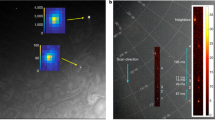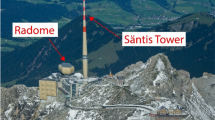Abstract
Light flashes are unusual visual phenomena that are observed in space and are caused by the interaction of energetic cosmic-ray particles with the human visual system. Using data gathered on board the Mir space station during the Sileye-2 experiment1, we show here that there are two separate components of cosmic rays that cause these flashes: one due to heavy nuclei and one due to protons. This indicates that perception by an astronaut's visual apparatus could involve two complementary mechanisms.
Similar content being viewed by others
Main
Ever since light flashes in space were predicted2 before the first space mission and subsequently reported by early Apollo astronauts, attempts to determine their cause have been made both in space and using ground-based particle accelerators3. As a result, several explanations have been proposed to account for the phenomenon (see ref. 4 and references therein).
The measured rate of occurrence of light flashes (LF) varies for different missions: on Mir5, it is much lower (Sileye-1, 0.18 ± 0.02 LF min−1; Sileye-2, 0.13 ± 0.01 LF min−1) than on Apollo6 (0.23 ± 0.1 LF min−1), Skylab7 (1.3 ± 0.1 LF min−1) and ASTP8 (0.46 ± 0.05 LF min−1). This effect is probably due chiefly to a reduction in the speed of low-energy particles by Mir's hull material (aluminium more than 3 mm thick) and the equipment inside the craft.
As light flashes are caused by particles interacting with the human visual apparatus, their occurrence should be proportional to particle rate (the so-called 'latitude effect'). Particle rates outside the region of the South Atlantic Anomaly (SAA) depend on the geomagnetic cut-off, which is a function of the position-dependent geomagnetic field intensity and direction. The cut-off C represents the minimum rigidity for cosmic rays to reach Mir's orbit without being deflected outwards; it is lower at high geomagnetic latitudes (for Mir's orbit, the lowest cut-off is C = 0.6 gigavolts (GV)) and higher at the geomagnetic equator (where maximum cut-off is C = 16 GV). The lower the cut-off, the higher the rate of particles coming from outside the Earth's magnetosphere (we use the vertical cut-off at each location of Mir).
Light-flash and particle rates measured inside Mir were divided in 3-GV bins that separated the regions outside (C ≤ 18 GV) and inside the SAA (3 ≤ C ≤ 15 GV, selected for Earth's magnetic field B < 2.5 × 10−5 tesla; Fig. 1). The light-flash rate, RLF, is plotted against the particle rate, P, for all particles (almost exclusively protons) in Fig. 1a. In Fig. 1b, RLF is plotted as a function of the rate of relativistic nuclei, Pn, with charge Z ≥ 6, obtained by selecting particles with high linear-energy transfer (>20 keV µm−1) to guarantee the complete removal of the proton component.
a, Plot of light-flash rate against proton rate; b, light-flash rate against particle rate for particles with linear-energy transfer of > 20 keV µm−1. Linear fits for each region are shown. Data are from the Sileye-2 experiment1, in which astronauts wore light-excluding helmets integrated with cosmic-ray particle-flux detectors, enabling the frequency of flashes to be recorded as a function of background flux and orbit position.
From the all-particle plot (Fig. 1a), it is possible to see that RLF is not linearly proportional to proton flux in all regions: in the SAA, it is roughly independent of proton rate (even though statistical errors preclude any further claim). For instance, at the centre of the SAA (9 ≤ C ≤ 12 GV), where particle rate is highest (P = 15.4 particles per cm2 s steradian−1, where steradian is a unit of spherical angle), the light-flash frequency is RLF = 0.18 min−1, which is only slightly higher than in other regions. This implies that the light flashes cannot be caused only by protons in all regions.
Figure 1b shows that frequencies of light flashes within the SAA are consistently higher than those for equivalent particle rates outside it, indicating that a further component must contribute to light flashes inside the SAA. Summing all observations in the SAA to reduce statistical errors, we obtain RLF = 0.15 ± 0.03 min−1, compared with a rate outside it (in the same cut-off interval of the SAA) of RLF = 0.06 ± 0.01 min−1. If heavy nuclei were the only cause of light flashes, these two values should overlap. The existence of two complementary mechanisms for light-flash perception could explain these observations: direct interaction of heavy nuclei with the retina, causing ionization or excitation, and proton-induced nuclear interactions in the eye (with a lower interaction probability) producing knock-on particles.
This explanation is also consistent with previous proposals3,6,7,8,9 and the fact that Mir data inside the SAA are halfway between Skylab's (112 light flashes in 12 min in the SAA) and those of Apollo–Soyuz (no light flashes in the SAA). This is due to the average orbital height and shielding of Mir with respect to the other two space stations. Our results provide further insight into the overall effects of the space environment on humans.
References
Bidoli, V. et. al. J. Phys. G 27, 2051–2064 (2001).
Tobias, C. A. J. Aviat. Med. 23, 345–372 (1952).
McNulty, P. J., Pease, V. P. & Bond, V. P. Science 201, 341–343 (1978).
Horneck, G. Nucl. Track Radiat. Meas. 20, 185–205 (1992).
Avdeev, S. et al. Acta Astronautica 50, 511–525 (2002).
Pinsky, L. S., Osborne, R. E., Bailey, J. V., Benson, R. E. & Thompson, L. F. Science 183, 957–959 (1974).
Hoffman, R. A., Pinsky, L. A., Osborne, W. Z. & Bailey, J. Z. NASA Report SP-377, 127–130 (1977).
Budinger, T. F. et al. NASA Report SP-412, 193–209 (1977).
Charman, W. N., Dennis, J. A., Fazio, G. G. & Jelley, J. V. Nature 230, 522–524 (1971).
Author information
Authors and Affiliations
Ethics declarations
Competing interests
The authors declare no competing financial interests.
Additional information
brief communications is intended to provide a forum for both brief, topical reports of general scientific interest and technical discussion of recently published material of particular interest to non-specialist readers. Priority will be given to contributions that have fewer than 500 words, 10 references and only one figure. Detailed guidelines are available on Nature's website (http://www.nature.com/nature) or on request from nature@nature.com
Rights and permissions
About this article
Cite this article
Casolino, M., Bidoli, V., Morselli, A. et al. Dual origins of light flashes seen in space. Nature 422, 680 (2003). https://doi.org/10.1038/422680a
Issue Date:
DOI: https://doi.org/10.1038/422680a
This article is cited by
-
Progress of quantum molecular dynamics model and its applications in heavy ion collisions
Frontiers of Physics (2020)
-
From international ophthalmology to space ophthalmology: the threats to vision on the way to Moon and Mars colonization
International Ophthalmology (2020)
-
Space radiation research in Europe: flight experiments and ground-based studies
Radiation and Environmental Biophysics (2010)
-
Cosmic ray investigations during the marco polo and eneide missions with the sileye-3/alteino experiment
Microgravity Science and Technology (2007)
-
Getting ready for the manned mission to Mars: the astronauts’ risk from space radiation
Naturwissenschaften (2007)
Comments
By submitting a comment you agree to abide by our Terms and Community Guidelines. If you find something abusive or that does not comply with our terms or guidelines please flag it as inappropriate.




